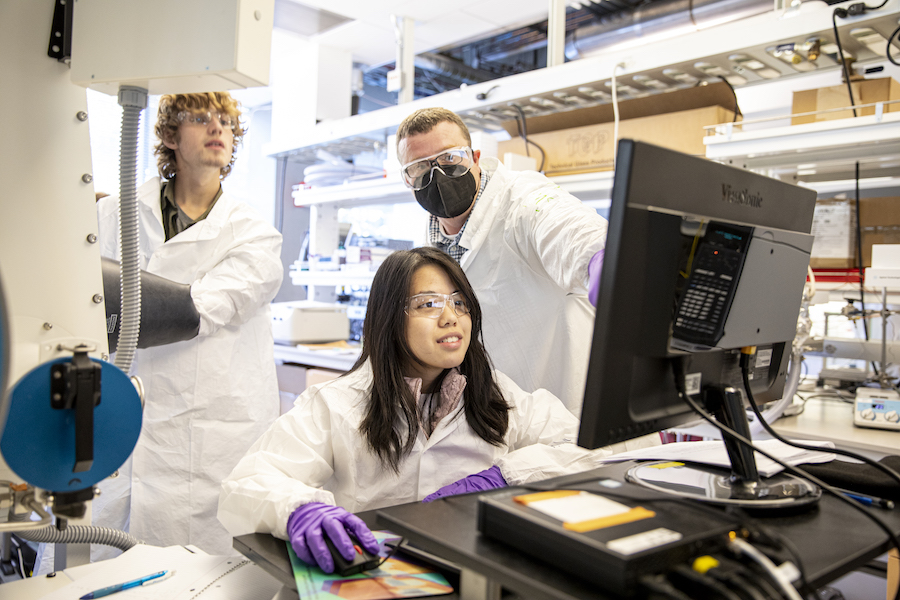Research Overview
Our researchers investigate materials that are abundant and environmentally benign, with the goal of creating high-efficiency solar cells using ultra-low-cost manufacturing processes. For example, hybrid perovskites are a rapidly improving class of materials for printable solar cells. Perovskites already match the efficiencies found in conventional silicon solar cells and can be printed like newspaper onto flexible materials. In addition, electronic polymers have the potential to transform solar cells—they are already improving consumer electronics, lighting, and displays.
Featured Researchers
Washington Clean Energy Testbeds Technical Director
Washington Research Foundation Innovation Professor in Clean Energy and Associate Professor of MSE and ME
Recent News
Washington Clean Energy Testbeds announces 2025 Undergraduate Research Awards
[vc_row][vc_column][vc_column_text css=".vc_custom_1742328785967{margin-top: 10px !important;margin-bottom: 20px !important;}"]Tristan Angeles, Dijia Bao, Andrea...
Washington Clean Energy Testbeds launches Undergraduate Research Awards
[vc_row][vc_column][vc_column_text css=".vc_custom_1715629295177{margin-top: 10px !important;margin-bottom: 20px !important;}"]UW students Sebastian Bustos-Nuno, Vyvyan...
An enlightening opportunity: solar scalability
[vc_row][vc_column][vc_column_text css=".vc_custom_1697481714211{margin-bottom: 20px !important;}"]By Brooke Fisher | Photos by Dennis...
Preparing tomorrow’s clean energy leaders
[vc_row][vc_column][vc_empty_space][mkd_section_title title="A multi-disciplinary course is training students across the scales...
Recent Publications
- Symmetry breaking in twisted double bilayer graphene (Nature Physics, September 2020) | UW News | Phys.org
- Suppressing efficiency roll-off at high-current densities for ultra-bright green perovskite light-emitting diodes (ACS Nano, April 2020)
- Photolithographic patterning of perovskite thin films for multicolor display applications (Nano Letters, April 2020)
- Active self-cleaning surface design for solar panels with water droplets (Applied Physics Letters, March 2020)
- Solar-to-fuel energy conversion: multi-pulse laser experiments reveal a new way to control chemical reactions with light (The Journal of Physical Chemistry, March 2020)
- Using machine learning to forecast the degradation of perovskites (ACS Energy Letters, February 2020)
- Understanding how solid catalysts powered by electricity convert organics in water to liquid hydrocarbons (Journal of Catalysis, January 2020)
- Cacao beans & green chemistry for QLEDs (Green Chemistry, December 2019)
- Inorganic nanopropeller puts a spin on catalysis (Journal of the American Chemical Society, November 2019)
- A proposal towards a scalable single-photon source to create a quantum simulator (ACS Photonics, November 2019)
- Photon upconversion through triplet– triplet annihilation for solar cells (ACS Applied Energy Materials, November 2019)
- Switching 2D magnetic states via pressure tuning of layer stacking (Nature Materials, October 2019)
- Organic Semiconductors at the University of Washington: Advancements in Materials Design and Synthesis and toward Industrial Scale Production (Advanced Materials, October 2019)
- Controlling three-dimensional optical fields via inverse Mie scattering (Science Advances, October 2019)
- Mapping strain in next-gen solar cells (Joule, September 2019) | UW News
- First-ever visualizations of electrical gating effects on electronic structure could lead to longer-lasting devices (Nature, July 2019) | UW News
- Hybrid perovskite films approaching the radiative limit with over 90% photoluminescence quantum efficiency (Nature Photonics, April 2018)












